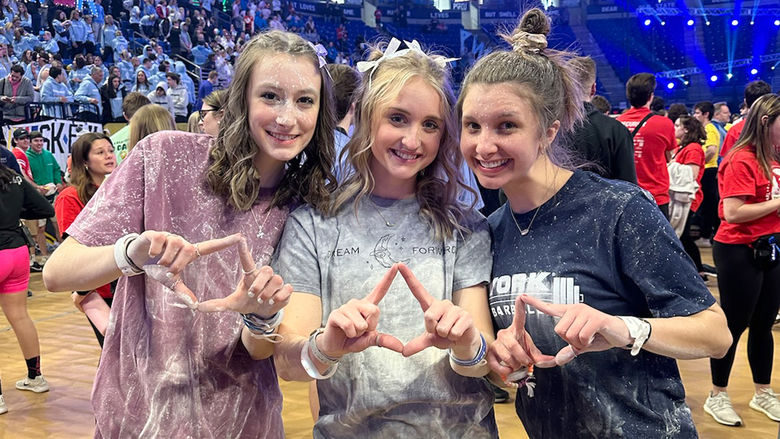

This dialog contains the full navigation menu for this site.

In the STAR Series, Professor of English Erin Murphy and Associate Professor of English Laura Rotunno invite faculty members to share their experiences in a lunch-hour lecture. The first program of this fall was by Lisa Emili, associate professor of physical geography and environmental studies, co-coordinator of the Environmental Studies program, and Sustainability coordinator. R&T editor Therese Boyd sat down with Emili to hear about her recent talk.
TB: What made you decide to do the STAR Series?
LE: Erin [Murphy] invited me. They try to get faculty from different disciplines. What’s woven through STAR is “how do we use our teaching and research to inform each other?” [As an instructor] you already come about it from a disciplinary standpoint. I wanted to use it as an opportunity to educate people about the Environmental Studies program and to market the idea that Environmental Studies is interdisciplinary in nature, from a curriculum standpoint. [The STAR Series is] just another way of outreach and having a different audience for me to get on my soapbox about how great the program is.
TB: So are you saying that some people don’t have the full picture when it comes to the Environmental Studies program? It’s more than just “how do we get clean water and clean air.” A number of faculty teach across disciplines, don’t they?
LE: Brian Black [division head and professor of history and environmental studies] teaches about environmental history, Nicholas Rowland [associate professor of sociology and environmental studies] might have students studying whether people will pay more for organics. And the way I teach my students, we are always talking about current events. There is just something unique about the program; Environmental Studies students get a very diverse and holistic education. And it’s hard to separate out teaching from research—in environmental studies they really are overlapping and combined.
TB: Why would a student choose the Environmental Studies program?
LE: There is some connection to the environment that starts you on the path. And that translates into a passion. Maybe it’s a chemical spill, maybe it’s learning about Erin Brockovich. My thing is place ... specifically Hamilton, Ontario, an urban area with suburban elements but threatened by urban issues. I grew up in the Red Hill Valley, the largest green space in that area. I grew up with the ability to literally go out my back door into nature. As I got older, then I really got to study the issues, to understand those issues. The Red Hill Creek in the Red Hill Valley is polluted. That’s the nexus for me.
TB: The title of your talk was “Getting Out and Doing It!” What is that a reference to?
LE: I have a firm belief in the “extended classroom,” whether it’s the Seminar Forest, or identifying trees on campus, or longer field trips. Each one of those things provides opportunities for learning by doing. We learn about fossils, then we go out and find those fossils. Day trips, spelunking, learning how what we do impacts the Chesapeake Bay—those are things where we’ve learned specifically.
TB: Sounds like your classes have a lot of fun, even with the work.
LE: I benefited from these trips as a student. The experience builds camaraderie through overnight trips, long bus rides, and even the time spent together when the bus has broken down. Something unique to Environmental Studies is they move together, a cohort of students, and there’s this overlapping of the professors that they have. They also benefit from professors and friends and the opportunities that develop because of that.
TB: So how much research do the students get to do?
LE: We have so many students doing undergrad research, some with me. It can also be something like independent study. They’re not make-work projects, they’re real-life things. I say, “You have to get this done. It has to go into a report.” When it’s time to present to the stakeholders, they go, I don’t. Two students, Tracie Cobb Irvin (Biology major with a minor in Environmental Studies) and Angela Spagnoli (Environmental Studies major), were part of an ongoing project to analyze stream water chemistry in three headwater streams (in Blair County) of the Chesapeake Bay. They just presented a poster titled “Sub-watershed nutrient data collection in the Juniata River watershed” at the PennTec 2016 conference, which is the annual meeting for the Pennsylvania Water Environment Association (PWEA).
TB: So what you’re saying is that Environmental Studies students learn both in the classroom and out, benefiting themselves and the environment, which helps everyone, correct?
LE: Our research is about community and what community we fit in and how we can make positive differences. My class visited the Last 44 Farm in Altoona to test the water quality of the property. We went out there and took samples, using it as a living laboratory. We continue to do what I call the greater good, fostering civic engagement. Civic engagement is not just getting out and doing it, not just studying it, but also asking what can we do to give back? As part of giving back, a group of students did a crowdfunding to build a permanent fire pit in the Seminar Forest. And so many of our alumni participate in our alumni mentoring program.
TB: For students in the Environmental Studies program, then, as you said at the beginning of your presentation: “Learning is not a spectator sport!”


